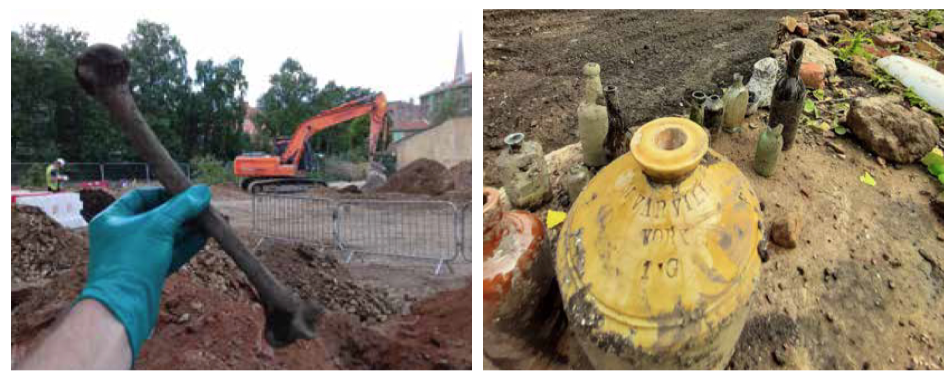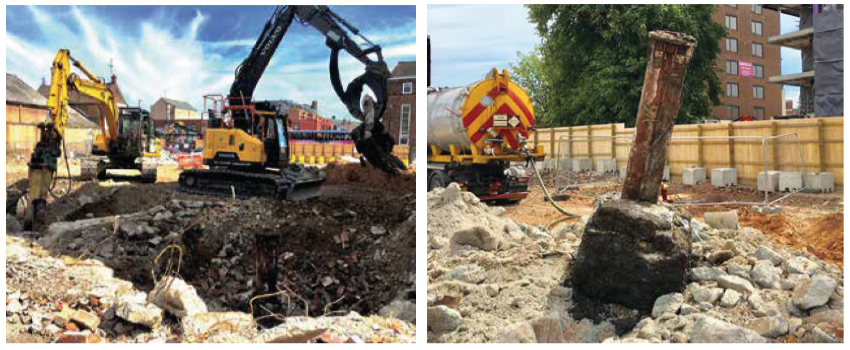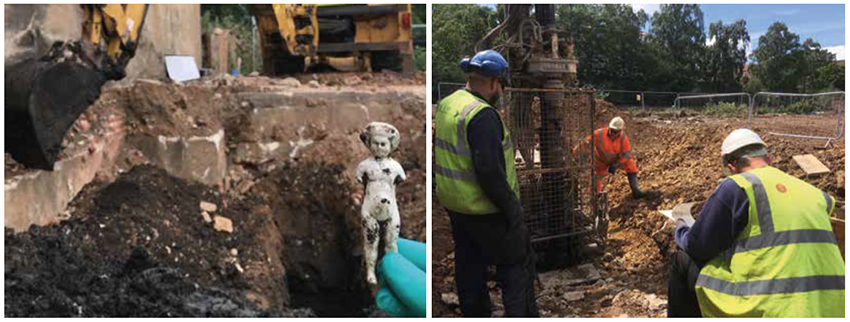“OIL IN THE BONES”
Remedial Strategy Development and Implementation in the context of Nationally Significant Archaeology
Geo² Remediation Ltd were invited by a luxury property developer to provide specialist in-situ remediation expertise for a complex site remediation scheme in the City of York. Serious challenges existed on site from both inorganic (asbestos and industrial made ground) and organic (free fuel oil and hydraulic oil plume) contaminants. The remediation has to be done in a way which would respect nationally significant archaeology underlying and local to the site. Agreement on the final remediation strategy involved complex multi-party negotiations balancing the needs of both Environmental and Archaeological stakeholders.
The remediation required targeted removal of deeply buried oil structures on-site (hydraulic jacks and nine fuel oil tanks), hotspot excavation and free phase skimming. The site was future proofed with a design including zoned gas membranes and sheet piling. The scheme was designed to protect and preserve the sensitive Roman and Viking heritage below the site for future generations!
The project, now in the final stages of completion was considered to be a “great example of best practice and collaboration” by the City Archaeologist given the negotiations around the specific and unusual regulatory demands on the project.
Site History
The site, an architecturally listed, asbestos clad former vehicle maintenance garage, is located in an area of nationally significant archaeological interest immediately alongside the River Foss, York. This area is one of the key interest areas for Roman occupation of Britain and later Viking invasion and settlement and building of the Medieval City of York. Our client, a prestigious hotel developer, instructed Geo² to provide specialist remediation solutions.
Site Geology and Hydrogeology
The soils under the site were found to be a mix of (Medieval to present) deep, soft and putrid waterlogged silts (~8m below ground level) bearing historic river revetments and significant organics, the occasional skeleton and medieval pig! These are underlain by a clay (Roman) aquitard protecting a principal aquifer in the sandstone below the City.

Contaminative Features
The site hosted an impressive array of contaminants, from human activity as early as the Roman occupation and metal smelting in York through to Medieval fly tipping and grave desecration!
The domed structure covering site was built entirely of asbestos and hid a range of contamination sources. Shallow soils showed hazardous concentrations of heavy metals and asbestos. Multiple deep hydraulic jacking structures (for lifting buses), leaky fuel tanks and ruptured interceptors were uncovered during the works. Emanating from these features a three hydrocarbon plumes (with both free oil and dissolved phase up to 70m³ in area) were uncovered, mingling with the Medieval bones and relics below.
Both the organic rich Viking silts and oozing degrading oil plumes were found to be producing explosive levels of dangerous gases and oil vapours!
Key Risks
The key risks these contaminative features presented included:
- Immediate threats to both River and Aquifer receptors and quality from multiple oil plumes.
- Ground gases from anaerobic degradation of organics, hydrocarbon plume decay and dissolved gases within groundwater moving into site;
- Risks to future site users and developers from heavy metals and asbestos in the shallow soils;
- Extremely soft ground conditions from the deep silts which could impact the stability of the development;
- Threats to the extremely significant Roman and Viking archaeology.

Regulatory Liaison
An experienced remediation team from Geo² liaised with both the Archaeology regulator, a specialist Archaeology consultancy and Contaminated Land Regulators from Local Authority and the Environment Agency to implement a highly targeted, risk-based remediation strategy respectful of the sustainable ethos of the development and the sensitive setting of the site.
Significant constraints on the scope of permitted remediation included:
- No site wide pumping or dewatering (this may alter groundwater chemistry and decay local buried archaeology);
- No excavation of horizons older than the Medieval period;
- No injection of chemicals to breakdown oils or alter the groundwater and to avoid aerobic degradation of the archaeology.
Remedial Solutions
From these complicated negotiations, Geo² implemented a strategy including:
- Piled barrier installation along the River face of the site to separate oils from the river;
- Specialist decommissioning and removal of oil infrastructure;
- Excavation and removal of shallow oil hotspots;
- Excavation of metalliferous and asbestos bearing made grounds;
- Pumped recovery of shallow groundwater plumes;
- Risk modelling and monitoring to enable safe natural degradation of the oil plumes on site.
Moving Forwards
The site will retain a series of monitoring boreholes for long-term groundwater monitoring in the York region. These will check that the remediation has been successful in years to come, and the archaeology of the site is being preserved for future generations after the development is finished.
Remediation Success
Our collaborative and sustainable approach to this challenge delivered the best outcome for the client, balancing the needs of our project partners in regenerating the site, preserving the archaeology and protecting the environment.


